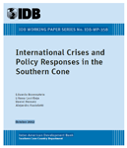International Crises and Policy Responses in the Southern Cone
Date
Oct 2012
This document analyzes the patterns of fiscal and monetary policy in five economies of the Latin American Southern Cone (Argentina, Brazil, Chile, Paraguay and Uruguay) during four episodes of international crises: 1994, 1997-1999, 2001 and 2008. In contrast with earlier episodes when most countries in the region applied procyclical fiscal and monetary policies, the response of the five countries to the 2008 crisis was countercyclical. On the fiscal side, countries had a larger fiscal space in 2008 to implement a countercyclical policy thanks to increases in primary balances, improvements in sustainability indicators and a reduction in financing needs in the years before the crisis. On the monetary side, the capacity to implement countercyclical policy was supported by a shift towards more flexible exchange rate regimes, and monetary policy regimes that enhanced transparency, reduced price volatility and increased the credibility of monetary authorities. For countries to be able to implement countercyclical responses in future crisis episodes, the fiscal authorities should reverse expansionary measures during good times and Central Banks should meet their inflation targets to preserve fiscal space and anchor inflation expectations.



